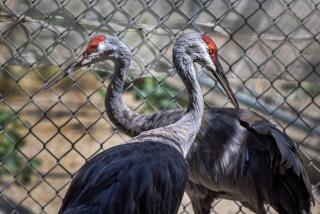Zoo Gives Lifeline to Philippine Deer
- Share via
SAN DIEGO — To explain why 15 pint-size deer that run like hogs have just arrived at the San Diego Zoo, it is probably best to start with Ferdinand and Imelda Marcos.
The Marcoses, as the world now knows, had significant shortcomings as geopolitical leaders, but they did have a soft spot for exotic animals.
After the couple went on a trip to Africa in 1976, the Philippine government was moved to establish a game preserve on the remote island of Calauit to accommodate 104 newly acquired animals, including zebras, giraffes, gazelles and other hoofed beasts.
The sanctuary also provided a good spot for the Calamian deer ( Cervis calamianensis ). The Calamian deer were once common throughout the Philippines but in recent decades had been hunted and hassled to the brink of extinction.
The 9,000-acre sanctuary on Calauit, called the only major conservation effort during Ferdinand Marcos’ long and despotic rule, proved just the ticket for the Calamian deer, and they populated quite encouragingly.
But Marcos was toppled from power in 1986 and, with one thing and another, including a move by the Calauit fishermen and farmers to return to the homes from which Marcos ousted them to make room for the sanctuary, the Calamian deer is again in dire need of assistance.
Poachers are particularly keen on the Calamian deer, which is considered an illicit delicacy in certain restaurants. Disease is adding to the toll.
And the destruction of the Philippine habitat by unrestrained logging and planting is considered a worldwide ecological scandal and has been the subject of several books, including “Plundering Paradise: The Struggle for the Environment in the Philippines” by American academics Robin Broad and John Cavanagh.
All of which has led the San Diego Zoo, which specializes in rescuing endangered species, to reach out to the Calamian deer.
No one is asserting that the Calamian deer have the mammalian charisma of other imperiled animals. “They’re not flashy like gorillas or okapi,” said Karen Killmar, the zoo’s associate curator of mammals.
Still, the goal of the zoo’s center for the reproduction of endangered species is to save the flashy and nonflashy alike so that survival is not determined by a popularity contest.
After delicate negotiations, 15 of the Calamian deer were flown from Manila to Poland and then to New York City for quarantine and then trucked to the San Diego Zoo, where they arrived last month for further quarantine and medical inspections. They are the only Calamian deer outside the Philippines.
“They’ve been through a lot,” Killmar said.
The zoo, which has the largest and most varied collection of deer of any zoo in the world, hopes that the immigrant herd of six males and nine females proves prolific and that young deer can be made available to other zoos. A zoo in France has already shown interest in the effort.
Although deer are not known for having reproductive problems, an effort by the Philippine government at building up the Calamian deer population on Calauit Island proved marginal and was abandoned in 1991. The hope had been that the deer would become so plentiful that they could be hunted legally, thus wiping out the poaching trade.
Named for the Calamian group of the Philippine Islands, the deer are part of the hog-deer family, so named because they straighten their heavily muscled backs and stick their muzzles forward like a wild hog when running through the forest. A male adult can be three feet tall at the shoulder and weigh more than 80 pounds.
Before the Calamian deer deal was sealed, the San Diego Zoo contracted with British conservationist and wildlife artist William L. R. Oliver to visit the sanctuary at Calauit and provide an assessment of the Calamian deer’s chances for survival.
Oliver, principal coordinator of the Philippine Threatened Endemic Mammal Conservation Program, reported seeing Calamian deer and other animals indigenous to the Philippines living in “bizarre juxtaposition” to African species such as zebras and giraffes. Mostly it’s a peaceful arrangement, but the giraffes have a tendency to deplete the supply of food that would be available for the deer.
Ominously, Oliver noted how casually the residents on Calauit and nearby islands talk about hunting and poaching. For that reason alone, he suggested that the zoo proceed with the plan to import the Calamian deer and encourage them to multiply.
“If Calauit survives, so may the Calamian deer,” Oliver wrote, “but one population is never enough.”
More to Read
Sign up for Essential California
The most important California stories and recommendations in your inbox every morning.
You may occasionally receive promotional content from the Los Angeles Times.













